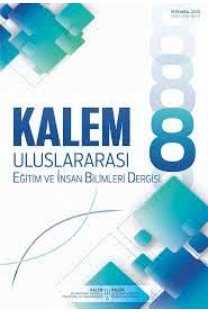Mikroskobik Canlılar Konusunda Model Tabanlı Öğrenme Yaklaşımının Öğrencilerin Zihinsel Model Gelişimine Etkisi
Araştırmanın amacı, Model Tabanlı Öğretim ve Öğrenme kapsamında tasarlanan etkinliklerin, ilkokul dördüncü sınıf öğrencilerinin mikroskobik canlıların tanımı, yapısı, işlevi, davranışı, mekânizması ve şekli ile ilgili olarak anlama seviyelerinde ve zihinsel modellerinde gelişimine etkisini incelemektir. Araştırmada gelişmiş karma yöntem desenlerinden müdahale deseni kullanılmıştır. Çalışma grubunu Kastamonu ili merkeze bağlı bir köy ilkokulunda öğrenim gören altı öğrenci oluşturmaktadır. Araştırmada veriler, öğretim uygulamalarından önce ve sonra “Mikroskobik Canlılar Kavram Testi” ve yarı yapılandırılmış görüşmeler yoluyla toplanmıştır. Kavram testinden elde edilen veriler anlama seviyeleri dikkate alınarak analiz edilmiştir. Nitel verilerin analizinde betimsel analiz yöntemi kullanılmıştır. Öğretim uygulamalarından önce ve sonra yapılan son görüşmeler karşılaştırıldığında öğrencilerin anlama seviyelerinde genel artış gözlenmiş ve araştırma dâhilinde mikroskobik canlılara yönelik olarak bilimsel modele ulaştığı görülmüştür. Model Tabanlı Öğretim ve Öğrenme uygulamaları mikroskobik canlılar ile ilgili olarak öğrencileri zihinsel model açısından bilimsel modele ulaştırmıştır. Ancak bazı öğrencilerde mikroskobik canlıların farklı boyutlarına yönelik eksik ve alternatif kavramların devam ettiği görülmektedir.
The Effect of Model-Based Learning Approach on Students’ Development of Mental Model about Microorganisms Subject
The aim of the present study was to investigate the effect of a learning environment designed in accordance with Model-Based Teaching and Learning method on fourth grade students’ levels of understanding and mental model development regarding the definition, structures, functions, behaviors, mechanisms and forms of microorganisms. In the study, mixed method was adopted. The sample consisted of 6 students from a school located in a village of the central district of Kastamonu province. Data were collected by means of “Microorganisms Concept Test” and semi-structured interviews both before and after the teaching practices. Data from the concept test were analyzed with due consideration to the levels of understanding of the students. Descriptive analysis was employed for the analysis of the qualitative data. When the final interviews conducted both before and after the teaching practices were compared and contrasted, students’ overall levels of understanding were found to rise and within the scope of the study, it was seen that they reached a scientific model concerning microorganisms. ModelBased Teaching and Learning practices promoted students, in terms of mental models, to reach the scientific model about microorganisms. However, it was also seen that incomplete and alternative conceptions about the different aspects of microorganisms persisted in some students’ minds.
